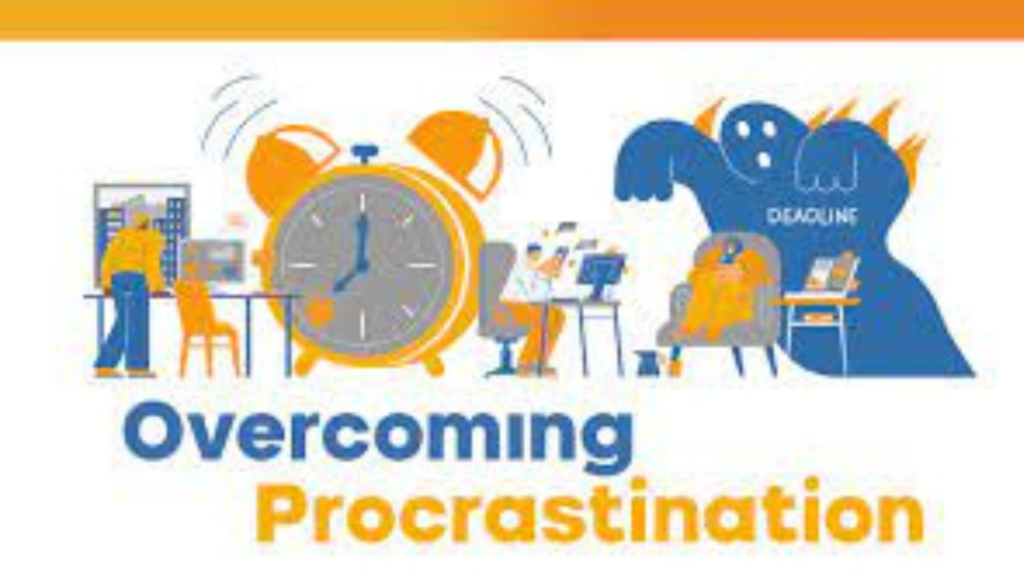Ah, overcoming procrastination. That moment when you find yourself scrolling through your social media feed for “just a few minutes,” which magically turns into hours, right when you’re up against a tight work deadline. It’s almost as if our brains are wired to self-sabotage exactly when we need to be at our best. While we might laugh it off later, the truth is, that procrastination is a dream killer. It eats away at our time, saps our focus, and keeps us from achieving the things that truly matter in our lives and we should find ways of overcoming procastination.
Why Do We Procrastinate?
Procrastination isn’t just about a lack of willpower; it’s a complex psychological issue. Drawing on insights from psychology, it’s clear that emotional and cognitive factors play a significant role.
Here are some key reasons:
- Fear of Failure: Many people procrastinate because the prospect of failing at a task is too overwhelming. Your brain goes into a protective mode, steering you away from potential failure.
- Imposter Syndrome: You may feel that you’re not good enough to accomplish the task at hand. This results in delaying or avoiding the task altogether.
- Perfectionism: The need to complete a task perfectly can be immobilizing. You may find yourself delaying the start because you fear not meeting your own high standards.
- Decisional Procrastination: Sometimes, procrastination occurs when you’re unable to make a decision. Your brain finds it easier to postpone the task rather than choose a course of action.
- Instant Gratification: Our brains are wired to prioritize immediate rewards over future gains, a concept known in psychology as “temporal discounting.”
- Avoidance Behavior: Linked to anxiety disorders, avoidance behavior is when you procrastinate to avoid emotionally uncomfortable situations.
- Self-Doubt: Lack of self-confidence can make tasks seem more daunting than they actually are, causing you to procrastinate.
Understanding these psychological mechanisms can arm you with the insights needed to tackle procrastination head-on.
The Costs of Procrastination
While procrastination might seem like a harmless diversion, its costs are real and far-reaching. Let’s put some numbers and stories to those costs:
- Lost Time: Did you know that the average person procrastinates for about 218 minutes a day? That’s almost four hours you could have spent on meaningful activities.
- Reduced Quality of Work: A colleague of mine had to redo an entire project because he started it the night before it was due. Not surprisingly, the quality was abysmal, and it took a toll on his professional credibility.
- Increased Stress: Studies show that 88% of the workforce reports feeling “extremely stressed” due to procrastination. Stress, as we know, can lead to a myriad of health problems.
- Opportunity Costs: Ever missed an early-bird discount for a conference or a workshop because you delayed registration? Those small losses can accumulate over time.
- Strained Relationships: A friend once procrastinated so much on planning a family vacation that by the time he got to it, all the affordable options were booked. It led to tension and disappointment within his family.
- Financial Consequences: A survey revealed that procrastination costs businesses an average of $10,396 per employee per year in lost productivity.
- Erosion of Self-Trust: On a personal note, I recall a time when I put off regular exercise, convincing myself I’d start “tomorrow.” Those tomorrows added up, affecting both my physical health and self-esteem.
Understanding these tangible and often painful costs can act as a catalyst to address procrastination head-on.
Identifying Your Procrastination Triggers
It’s one thing to understand the costs of procrastination; it’s another to pinpoint what specifically sets you off on a detour. Moreover, recognizing your triggers can be a game-changer.
Here’s a guide to help you identify them:
- What Tasks Do You Procrastinate On?: Is it work assignments, household chores, or personal projects? Make a list.
- When Do You Procrastinate?: Is it during a particular time of day, or when you’re in a specific mood? Take note.
- What Are You Doing Instead?: Are you scrolling through social media, watching TV, or perhaps overcommitting to less important tasks?
- What Thoughts Run Through Your Mind?: Are you thinking, “I’ll do it later,” “I work better under pressure,” or “I need to be in the right mood”?
- How Do You Feel Before Procrastinating?: Anxious? Overwhelmed? Bored? Identifying the emotion can help you understand the trigger.
- Who Are You With?: Are there people who make you more prone to procrastination? Sometimes our environment plays a role.
- What’s the Immediate Reward?: Are you seeking the comfort of an easy task, the thrill of last-minute work, or simply avoiding discomfort?
- Have You Set Unrealistic Goals?: Sometimes our goals are so lofty that they seem unattainable, causing us to procrastinate. Are your objectives realistic?
To make this exercise practical, consider journaling your answers or discussing them with a trusted friend or coach.Additionally, you’ll often find patterns that point clearly to your unique triggers.
Strategies to Overcome Procrastination
So, you’ve identified your triggers. Great job! Now comes the real work—overcoming procrastination. Here are some actionable strategies that work, with some NLP techniques thrown in for good measure:

- Prioritize Your Tasks: Use the Eisenhower Matrix to categorize tasks as urgent/important, important/not urgent, etc. This will help you decide what needs your immediate attention.
- Tip: Spend most of your energy on tasks that are important but not urgent to prevent last-minute scrambles.
- Break It Down: Large tasks can be overwhelming. Break them down into smaller, more manageable parts.
- NLP Technique: The “Chunking Technique” in NLP is about breaking larger tasks into smaller, more manageable parts, reducing overwhelm.
- Set Specific Deadlines: Give yourself a time-frame to complete tasks, even if they don’t have external deadlines.
- Tip: Use a timer like the Pomodoro Technique to work in focused intervals.
- Eliminate Distractions: Create a dedicated workspace and limit distractions like social media.
- NLP Technique: Use “Anchoring” to associate this space with focus and productivity, so it becomes a trigger for effective work.
- Visualize Success: Before you start, take a moment to visualize the task’s successful completion.
- NLP Technique: The “SWISH Technique” helps you visualize a desired outcome, making it more likely you’ll achieve it.
- Hold Yourself Accountable: Tell someone about your task and deadline. The added pressure often helps.
- Tip: Accountability partners or tracking apps can be effective in maintaining consistency.
- Start Small: If you’re struggling to begin, aim to work on the task for just 5 minutes. Often, starting is the hardest part.
- NLP Technique: Use “Anchoring” again to link the act of starting with positive emotions.
- Be Kind to Yourself: If you do slip up, don’t be too hard on yourself. Acknowledge the setback and move forward.
- Tip: Positive reinforcement is more effective than punishment. Celebrate your small wins.
By combining these strategies with insights into your triggers, you’re setting yourself up for a far more productive life.
Productivity Techniques to Beat Procrastination
Sometimes, a little structure goes a long way in combatting procrastination. Here are some tried-and-true productivity techniques tailored to help you fend off the procrastination bug:
- Pomodoro Technique: Break your work into intervals—usually 25 minutes—separated by short breaks. Each interval is known as a ‘Pomodoro.’
- How it Fights Procrastination: By splitting tasks into manageable time slots, the Pomodoro Technique reduces the overwhelm that often leads to procrastination.

- ABCDE Method: This method involves assigning a letter (A, B, C, D, or E) to tasks based on their importance and urgency. ‘A’ tasks are most crucial, while ‘E’ tasks are least.
- How it Fights Procrastination: By clearly ranking your tasks, the ABCDE Method nudges you to focus on high-priority activities first, leaving little room for procrastination.
- Time Blocking: Assign specific blocks of time to different tasks or types of work. Essentially, you’re planning out every moment of your day in advance.
- How it Fights Procrastination: With a set schedule, you’re less likely to drift aimlessly, which makes it easier to stick to your tasks.
- Two-Minute Rule: If it takes less than two minutes, do it right away.
- How it Fights Procrastination: This rule encourages immediate action, helping to clear small tasks that can otherwise accumulate and become overwhelming.
- Kanban Method: This visual tool allows you to optimize your workflow by representing tasks on a board, making the status of each task visible at a glance.
- How it Fights Procrastination: By visualizing your workflow, you become more motivated to move tasks along to completion. It helps you identify bottlenecks and prioritize effectively.
Feel free to adapt these techniques to better suit your unique work style and procrastination triggers.
Creating an Action Plan to Overcome Procrastination

Knowing what to do is only half the battle; the other half is actually doing it. This is where an action plan comes in handy. An action plan is your roadmap, outlining the specific steps you need to take to squash procrastination once and for all.
Here’s a simple guide to creating your own action plan:
Step 1: Self-Assessment
- Take a few moments to identify your unique procrastination triggers. You can refer to the set of questions we discussed earlier.
Step 2: Set SMART Goals
- Be Specific, Measurable, Achievable, Relevant, and Time-bound when setting your goals. For example, instead of saying, “I want to be more productive,” say, “I will work on my project for 30 minutes every day this week.”
Step 3: Prioritize with ABCDE Method
- Rank your tasks based on importance and urgency, as discussed earlier in the ABCDE Method. Make sure to tackle ‘A’ tasks first.
Step 4: Choose Your Productivity Technique
- Pick one or more of the productivity techniques discussed above, like the Pomodoro Technique or Time Blocking, and integrate them into your daily routine.
Step 5: Accountability
- Whether it’s a friend, family member, or even an app, find a way to hold yourself accountable. Knowing that someone is checking up on you can be a strong motivator.
Step 6: Review and Adjust
- At the end of each week, assess what’s working and what’s not. Make adjustments as needed. If the Pomodoro Technique didn’t work for you, perhaps Time Blocking will.
Step 7: Celebrate Small Wins
- Reward yourself for the small milestones. These positive reinforcements will help keep you on the right track.
Case Studies/Success Stories: Real-Life Transformations with Coach Charli
Wondering if it’s possible to kick procrastination to the curb for good? Here are a few stories from clients I’ve had the privilege to coach. Their journeys are not just proof of what’s possible, but also a testament to the personalized strategies we developed together.
Case Study 1: Jane, The Busy Mom
Jane was an overwhelmed mom balancing a job, three kids, and a home. Her go-to coping mechanism? Procrastination. We worked together to implement SMART goals and the Pomodoro Technique. The results were staggering. Jane became more efficient, more present, and less stressed. If a busy mom can turn it around, so can you!
Case Study 2: Tom, The Corporate Climber
Tom was a rising corporate star until procrastination cost him a promotion. During our NLP coaching sessions, we applied techniques like anchoring to alter his responses to stress. Tom not only secured the next promotion but also became a productivity role model for his team.
Case Study 3: Sara, The Student with Chronic Illnesses
Sara was a university student dealing with multiple chronic illnesses. Given her health challenges, she couldn’t afford to procrastinate, but she did. We identified her triggers and implemented a blend of the ABCDE prioritizing method and time blocking. Sara not only graduated but did so with honors.
My Personal Journey
And let me share a bit about my own experience. I’ve had to navigate the challenges of chronic illnesses while pursuing multiple degrees and raising a family. However, through a combination of NLP techniques like the SWISH method and traditional productivity hacks, I managed to stay on track. And if I can do it, so can you.
Concluding Thoughts: Take the Leap, Not the Lull
So there we have it! Procrastination is not just an inconvenient habit; it’s a hurdle that can cost us time, opportunities, and even our well-being. But as we’ve seen from the real-life stories of Jane, Tom, and Sara, and even a snippet from my own journey, it’s a hurdle that can be cleared.
psychological roots of procrastination
We’ve dissected the psychological roots of procrastination, assessed its hidden costs, and provided you with actionable strategies to identify triggers and conquer the procrastination monster. We’ve even shown you how established productivity techniques and NLP methods can make a significant difference.
So what’s stopping you? No more “I’ll do it later” or “I’ll start on Monday.” The perfect time to take action is now, because the cost of waiting is far too high. Your future self will thank you, trust me.

Ready to kick procrastination to the curb? Your first step starts here, today. Because let’s face it, if not now, when?
Additional Resources: Arm Yourself for the Battle Against Procrastination
If you’re looking to dive deeper into the realm of productivity and banish procrastination for good, these resources come highly recommended. From books to apps and even courses, consider these tools your go-to armory.
Books
- “Eat That Frog!” by Brian Tracy: This book offers 21 practical ways to stop procrastinating and get more done.
- “The Now Habit” by Neil Fiore: A psychologist’s guide to mastering procrastination, Fiore shares incredible insights into the mind of a procrastinator.
Apps
- Forest: Plant a virtual tree that only grows if you don’t touch your phone. A great way to keep distractions at bay!
- Be Focused: This app breaks your work into intervals with short breaks in between, leveraging the Pomodoro Technique.
Courses
- “Getting Things Done” by David Allen: An online course that helps you streamline your workflow and become more productive.
- My Own NLP Coaching Sessions: For personalized guidance, consider signing up for my NLP coaching. We’ll tackle your specific triggers and tailor a productivity plan just for you.
There you go! Take advantage of these resources and fortify your commitment to a procrastination-free life.
Here are a few of our most recent blog posts:
- Time Management Hacks for ADHD: How to Keep Your Focus and Get Things Done!
- Tips on Boosting Self-Confidence for Teens
- Common Meditation Problems
- Common Goal Setting Obstacles and How to Maneuver around Them
- Committing Yourself to Positive Actions
If you’d like to follow me on social media, you can find all of my links HERE
Get It Done Faster!

Just click the picture to get your free copy now!
Includes free eBook AND free workbook, including worksheets and instructions for each of the techniques!
Designed specifically for those on the go, dive deep into the art of rapid productivity. Every moment matters; make the most of it.
In a world that incessantly pushes for more hours, more hustle, and more grind, a revolutionary approach is quietly rewriting the rules of productivity. Have you ever found yourself staring at the clock, wondering where the day went and why your to-do list remains untouched? You’re not alone. The common belief is that longer hours equate to more accomplishments, but what if the key isn’t more time, but how you use it?
Introducing “Get It Done Faster” — a game-changing technique that capitalizes on our brain’s natural rhythms and energy peaks. Instead of laboring for hours on end and burning out, imagine achieving more in short, focused intervals, punctuated by refreshing breaks. It’s not about working harder; it’s about working smarter. This method, inspired by tools like the Pomodoro technique and the Eisenhower matrix, taps into the sweet spot of productivity, ensuring that you’re operating at your peak when it matters most.
The links on this page may be affiliate links. That means that if you make a purchase using these links, I may receive a commission. This does not change the cost for you.


Leave a Reply